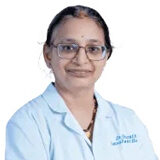Signs & Symptoms of Breast Cancer You Need to Know

Signs & Symptoms of Breast Cancer You Need to Know
Dr. Gayathri Gadiyaram
India’s Leading Breast Imaging Expert
 Breast cancer is the most common cancer affecting Indian women.[1] No one can prevent it. So, early detection plays a vital role in successful treatment and improved outcomes. Hence you need to know the signs and symptoms of breast cancer:
Breast cancer is the most common cancer affecting Indian women.[1] No one can prevent it. So, early detection plays a vital role in successful treatment and improved outcomes. Hence you need to know the signs and symptoms of breast cancer:
- Breast Lump or Thickening: While not all lumps are cancerous, get any new lump or mass that you feel, examined by your doctor. A lump or thickening in the breast tissue is often the most noticeable sign of breast cancer.
- Changes in Breast Size or Shape: If you notice a sudden change in the size or shape of your breast, please consult your doctor. This could be a sign of an underlying issue, including breast cancer.
- Nipple Changes: Please don’t ignore any changes in the nipples, such as nipple inversion, redness, scaliness, discharge, or pain. Get any of these changes medically evaluated.
- Skin Changes: Pay attention to any unusual changes in the skin of the breast, such as redness, dimpling, puckering, or a rash. These changes may indicate the presence of cancer cells.
- Breast Pain: Although breast pain is not typically associated with breast cancer, persistent or unexplained pain in the breast or armpit area should be investigated further.
- Swelling or Lumps in the Armpit: Breast cancer can cause swelling or lumps in the lymph nodes located in the armpit area. If you notice any abnormalities in this region, it is essential to seek medical advice.
- Breast Discomfort: Persistent discomfort or a feeling of heaviness in the breast that does not go away should not be ignored. While it may not always be cancer-related, it is better to get it diagnosed by your doctor.
Should you wait until you notice a symptom?
No. It’s wiser not to wait till any symptom shows up.
All women carry at least an average risk of breast cancer after puberty, with increasing risk as you age. About 50% of breast cancers develop in women with no identifiable risks other than gender and age. [2] Some women are at higher risk than this due to family history, breast density, genetics, personal history of breast disease, obesity, smoking, etc.
What is the wise approach?
If you are 40 with no symptoms or identifiable breast cancer risk, it’s time for you to start annual screening mammograms. Start earlier if you are in a higher risk category, in consultation with your doctor.
Mammography is the gold standard test for early breast cancer detection. [3] Breast cancer deaths are reduced by 30% to 50% with annual screening mammography performed on all women beginning at age 40 years. [4]
Why not self-breast-exam?
Breast self-examination is not recommended by most medical organizations worldwide [5] because it does not help early detection. By the time the lump is big enough to be felt by your or your doctor’s hands, it’s already too big and too late. Similarly, ultrasound and MRI too are not recommended for routine screening.
Mammography is only an imaging test with no cuts, pricks, or admission to the hospital, etc. You can either take a prior appointment or walk in if the center advises, so for mammography, that usually takes only a few minutes, excluding waiting time. Within those few minutes, your breast tissue will be compressed only for less than 10 seconds in the latest 3D Mammography machines to take clear images and avoid recalls.
Which type of mammogram and centre to select?
You deserve access to the best of technology & facilities when it’s time for your annual mammogram.
Please check if the center has at least a digital or the latest 3D mammography machine. The latest 3D mammography machines are designed to deliver the fastest and the highest resolution mammograms, with more comfort, and at the lowest radiation dose within the allowable limits.
Radiologists are specialist medical doctors who study your mammograms and interpret the scans for you. Usually, the center’s website will have detailed information about the doctor’s qualifications, experience, advanced training or fellowship in radiology, etc. This may give you a good idea about the professional expertise at the Centre.
Hence, if you are eligible for breast screening either by age (40 years and above) or due to high-risk factors such as family history (in which case even if you are younger than 40 years), subscribe today to an Annual Screening Mammography plan and never miss your test – A simple ritual that can save your life!

Dr. Gayathri Gadiyaram, Senior Consultant Radiologist
Care Hospitals, Hi-Tec City, Hyderabad
- Malvia S, Bagadi SA, Dubey US, Saxena S. Epidemiology of breast cancer in Indian women. Asia-Pacific Journal of Clinical Oncology. 2017;13(4):289-295. doi: https://doi.org/10.1111/ajco.12661
- https://www.who.int/news-room/fact-sheets/detail/breast-cancer Accessed 16 Sep 2022
- https://www.webmd.com/breast-cancer/features/mammography-still-gold-standard-for-breast-cancer Accessed on 23 Aug 2022.
- Feig S. Comparison of Costs and Benefits of Breast Cancer Screening with Mammography, Ultrasonography, and MRI. Obstetrics and Gynecology Clinics of North America. 2011;38(1):179-196. doi 10.1016/j.ogc.2011.02.009
- https://www.mayoclinic.org/tests-procedures/breast-exam/about/pac-20393237. Accessed on 19 Dec 2022.
